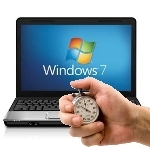
By Miguel Leiva-Gomez for MakeTechEasier.com
6 Useful Tips to Help Windows 7 Run Faster
At this moment, you’re probably satisfied with how Windows 7 runs, but you probably want to squeeze as much juice as you can out of it. Despite the improvements, the operating system still takes up resources that didn’t necessarily have to be used for normal functions. Let’s have a look at a few of those you can turn off!
1. Disable Search Indexing
One of the most resource-hungry features of Windows 7 is search indexing, which creates a dictionary for your files, allowing you to perform faster searches. The problem is that, while it’s creating that dictionary, it consumes your hard drive’s read/write speeds significantly, making it difficult to navigate through applications while indexing is taking place. That’s why Microsoft included an option to turn this off.
To effectively disable this feature, follow through this path: “Start -> Control Panel -> System and Security -> Administrative Tools -> Computer Management -> Services”. Once in that window, scroll down to “Windows Search.” Right-click the item and click “Properties.” Within the window, select “Disable” under “Startup type,” like so:

Click “OK” once finished. Once you reboot or stop the service manually, you won’t have to worry about your hard disk being eaten alive.
2. Disable Aero
If your computer gets kind of clunky while playing a movie or has difficulty emulating the graphics when you minimize or open a window, it’s probably time to sacrifice the pretty effects that Windows 7 Aero brings with it and just live with simple bland colors. The interface will function similarly to how Windows 7 Starter does. Removing Aero will give your computer a little more breathing room, especially if the display adapter uses some of the PC’s physical memory to perform.
Remove Aero by right-clicking your desktop, clicking “Personalize,” scrolling down the list of themes that appear, and selecting “Windows Basic.” You’re done!

Article Continued Here
This excerpt is shared with permission from maketecheasier.com.



